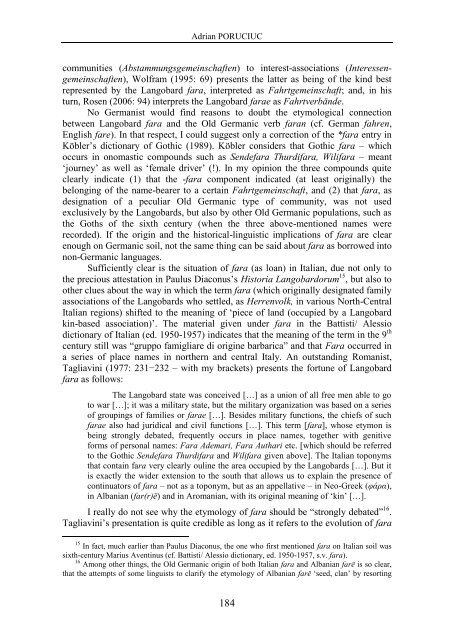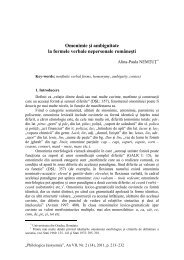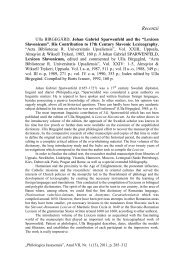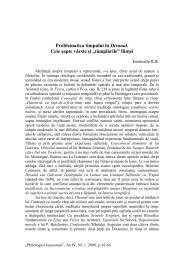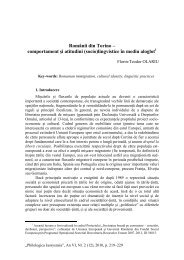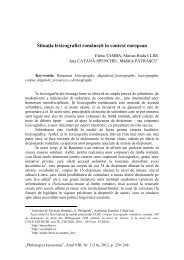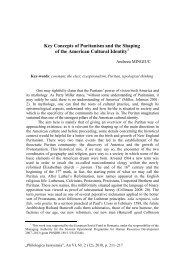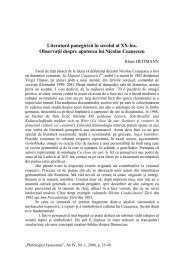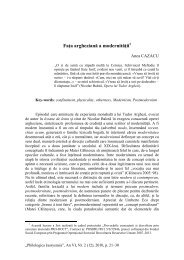O sutÄ de ani de cartografie lingvisticÄ româneascÄ - Philologica ...
O sutÄ de ani de cartografie lingvisticÄ româneascÄ - Philologica ...
O sutÄ de ani de cartografie lingvisticÄ româneascÄ - Philologica ...
You also want an ePaper? Increase the reach of your titles
YUMPU automatically turns print PDFs into web optimized ePapers that Google loves.
Adrian PORUCIUC<br />
communities (Abstammungsgemeinschaften) to interest-associations (Interessengemeinschaften),<br />
Wolfram (1995: 69) presents the latter as being of the kind best<br />
represented by the Langobard fara, interpreted as Fahrtgemeinschaft; and, in his<br />
turn, Rosen (2006: 94) interprets the Langobard farae as Fahrtverbän<strong>de</strong>.<br />
No Germ<strong>ani</strong>st would find reasons to doubt the etymological connection<br />
between Langobard fara and the Old Germ<strong>ani</strong>c verb faran (cf. German fahren,<br />
English fare). In that respect, I could suggest only a correction of the *fara entry in<br />
Köbler’s dictionary of Gothic (1989). Köbler consi<strong>de</strong>rs that Gothic fara – which<br />
occurs in onomastic compounds such as Sen<strong>de</strong>fara Thurdifara, Wilifara – meant<br />
‘journey’ as well as ‘female driver’ (!). In my opinion the three compounds quite<br />
clearly indicate (1) that the -fara component indicated (at least originally) the<br />
belonging of the name-bearer to a certain Fahrtgemeinschaft, and (2) that fara, as<br />
<strong>de</strong>signation of a peculiar Old Germ<strong>ani</strong>c type of community, was not used<br />
exclusively by the Langobards, but also by other Old Germ<strong>ani</strong>c populations, such as<br />
the Goths of the sixth century (when the three above-mentioned names were<br />
recor<strong>de</strong>d). If the origin and the historical-linguistic implications of fara are clear<br />
enough on Germ<strong>ani</strong>c soil, not the same thing can be said about fara as borrowed into<br />
non-Germ<strong>ani</strong>c languages.<br />
Sufficiently clear is the situation of fara (as loan) in Italian, due not only to<br />
the precious attestation in Paulus Diaconus’s Historia Langobardorum 15 , but also to<br />
other clues about the way in which the term fara (which originally <strong>de</strong>signated family<br />
associations of the Langobards who settled, as Herrenvolk, in various North-Central<br />
Italian regions) shifted to the me<strong>ani</strong>ng of ‘piece of land (occupied by a Langobard<br />
kin-based association)’. The material given un<strong>de</strong>r fara in the Battisti/ Alessio<br />
dictionary of Italian (ed. 1950-1957) indicates that the me<strong>ani</strong>ng of the term in the 9 th<br />
century still was “gruppo famigliare di origine barbarica” and that Fara occurred in<br />
a series of place names in northern and central Italy. An outstanding Rom<strong>ani</strong>st,<br />
Tagliavini (1977: 231−232 – with my brackets) presents the fortune of Langobard<br />
fara as follows:<br />
The Langobard state was conceived […] as a union of all free men able to go<br />
to war […]; it was a military state, but the military org<strong>ani</strong>zation was based on a series<br />
of groupings of families or farae […]. Besi<strong>de</strong>s military functions, the chiefs of such<br />
farae also had juridical and civil functions […]. This term [fara], whose etymon is<br />
being strongly <strong>de</strong>bated, frequently occurs in place names, together with genitive<br />
forms of personal names: Fara A<strong>de</strong>mari, Fara Authari etc. [which should be referred<br />
to the Gothic Sen<strong>de</strong>fara Thurdifara and Wilifara given above]. The Italian toponyms<br />
that contain fara very clearly ouline the area occupied by the Langobards […]. But it<br />
is exactly the wi<strong>de</strong>r extension to the south that allows us to explain the presence of<br />
continuators of fara – not as a toponym, but as an appellative – in Neo-Greek (φάρα),<br />
in Alb<strong>ani</strong>an (far(r)ë) and in Arom<strong>ani</strong>an, with its original me<strong>ani</strong>ng of ‘kin’ […].<br />
I really do not see why the etymology of fara should be “strongly <strong>de</strong>bated” 16 .<br />
Tagliavini’s presentation is quite credible as long as it refers to the evolution of fara<br />
15 In fact, much earlier than Paulus Diaconus, the one who first mentioned fara on Italian soil was<br />
sixth-century Marius Aventinus (cf. Battisti/ Alessio dictionary, ed. 1950-1957, s.v. fara).<br />
16 Among other things, the Old Germ<strong>ani</strong>c origin of both Italian fara and Alb<strong>ani</strong>an farë is so clear,<br />
that the attempts of some linguists to clarify the etymology of Alb<strong>ani</strong>an farë ‘seed, clan’ by resorting<br />
184


